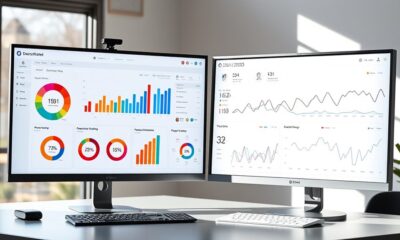Personal Goal Tracking
Bullet Journal vs. Digital Apps: Which Tracker Fits Your Brain?
Maybe your perfect tracker is one that matches your brain—discover which, bullet journal or digital apps, truly fits your style.
Choosing between a bullet journal and digital apps depends on how you prefer to organize and stay motivated. If you enjoy hands-on activities, tactile experiences, and creative customization, a bullet journal might suit your brain better. On the other hand, if you value quick access, automation, and seamless tech integration, digital apps could be more effective. Consider your style to find what works best. Keep exploring to discover which approach aligns perfectly with your needs.
Key Takeaways
- Choose a bullet journal if you prefer tactile, creative engagement that reinforces memory and ownership; opt for digital apps if you prioritize efficiency and quick access.
- Bullet journals suit visual thinkers who benefit from color coding and manual customization; digital apps cater to those who prefer organized, easily editable layouts.
- Physical journals offer screen-free, personalized planning, while digital apps provide seamless syncing, searchability, and remote access across devices.
- The best tracker depends on whether your brain responds better to manual, artistic interaction or automated, technology-driven organization.
- Consider your engagement style: consistent use and reduced overwhelm are key, so select the method that aligns with your natural planning preferences.

Choosing between a bullet journal and digital apps depends on your personal preferences and how you like to organize your life. If you enjoy a hands-on approach to planning, a bullet journal might be the perfect fit. One of its biggest advantages is the ability to use color coding to categorize tasks, events, or priorities. With color coding, you can instantly recognize what’s urgent, what’s upcoming, or what can wait, making your daily planning more visual and intuitive. This method appeals to those who respond well to color and visual cues, helping to reduce decision fatigue and keep your mind focused. Additionally, bullet journals offer extensive customization options. You can design layouts that suit your style, whether that’s minimalistic, artistic, or functional. You can incorporate trackers, doodles, notes, or inspirational quotes, crafting a personalized space that motivates you to stay organized. The tactile experience of writing in a journal also helps reinforce memory and commitment to your goals, giving you a sense of ownership over your planning process. Using a physical journal can also provide a break from screen time, which can be beneficial for mental clarity.
On the other hand, digital apps provide a different kind of flexibility. They often come with built-in features like reminders, notifications, and syncing across devices, which can streamline your organization. If you prefer a more structured approach, digital apps let you create templates, recurring tasks, and automated alerts that keep you on track without manual updates. Many apps also support color coding, allowing you to categorize tasks visually within the digital space, just like with a bullet journal. The customization options here might include different themes, layouts, and integrations with other tools, such as calendars or project management apps. This makes managing complex schedules or collaborative projects easier. Plus, digital platforms allow you to search your notes instantly, access your planner from anywhere, and back up your data securely. If you’re someone who values efficiency and technological convenience, digital apps can adapt to your needs seamlessly. Furthermore, some digital apps utilize cloud storage to ensure your data is safe and synchronized across devices.
Ultimately, the choice boils down to how you prefer to engage with your planning. If you value a tactile, creative process with the freedom to customize visually and physically, a bullet journal might suit you best. But if you lean toward automation, quick access, and integration with technology, digital apps can serve you more efficiently. Both options can be tailored to fit your brain’s style—whether that’s through color coding, customization options, or digital features. The key is to choose what makes you more inclined to stick with your routines without feeling overwhelmed or disconnected.
Frequently Asked Questions
Can Bullet Journals Be Easily Customized for Specific Needs?
You’ll find that bullet journals offer excellent customization for specific needs thanks to their personalization options and layout flexibility. You can easily adapt pages, add sections, or change styles to suit your goals. Unlike rigid digital apps, bullet journals let you tailor every aspect, ensuring the system works perfectly for your unique routines. This hands-on approach makes it simple to create a personalized tracker that evolves with your changing needs.
Do Digital Apps Integrate With Other Productivity Tools?
Think of digital apps as your personal Hermes, seamlessly delivering messages. They often feature impressive sync capabilities and cross-platform integration, so your tasks stay updated across devices. This means you can start planning on your phone, review on your tablet, and finalize on your laptop without missing a beat. With these features, digital apps boost your productivity by keeping everything connected and accessible, just like modern communication at its finest.
Which Option Is Better for Visual Learners?
If you’re a visual learner, digital apps might be better for you because they often feature color coding and customizable visual layouts. These tools let you easily organize information with vibrant colors and intuitive designs, helping you grasp concepts faster. Bullet journals can also be visual, but digital apps offer more flexibility for dynamic, eye-catching visuals. Choose the one that lets you see and understand your tasks at a glance.
How Do Physical and Digital Trackers Handle Data Security?
Think of your data as a treasure chest; physical trackers lock it with a key, offering simple security but risking physical loss. Digital trackers, on the other hand, rely on encryption methods that scramble your info, making it hard for outsiders to access. Always check privacy policies to understand how your data is stored and protected. Both methods can be secure if you choose reputable tools and keep your passwords strong.
Are There Hybrid Methods Combining Both Bullet Journals and Apps?
You can explore hybrid integration by combining bullet journals and digital apps to suit your needs. This approach offers customization options, letting you enjoy the tactile satisfaction of writing while benefiting from the convenience of digital features like reminders and backups. By blending both methods, you create a flexible system that adapts to your workflow, making task management more personalized and efficient.
Conclusion
So, whether you’re weaving your life through ink-stained pages or riding the sleek waves of digital screens, remember—your perfect tracker is the compass that guides your journey. Like a trusty sidekick or a shimmering star, it lights your path and keeps you on course. Choose what feels like home in your mind and heart, and watch your goals blossom like a garden in full bloom. Your ideal system is waiting to help you thrive.
Personal Goal Tracking
From Paper to Pixels: Migrating Legacy Journals Into Digital Trackers
How to seamlessly convert your legacy journals into digital trackers while ensuring accuracy and long-term security? Keep reading to discover the essential steps.

To migrate legacy journals into digital trackers, start by evaluating the volume, formats, and quality of your records. Choose appropriate OCR tools and software that support bulk uploads, automation, and robust search features. Develop a clear workflow, maintain detailed logs, and verify data accuracy throughout the process. Implement regular backups and update your digital archives to ensure long-term preservation. Keep exploring to discover how to streamline each step efficiently and securely.
Key Takeaways
- Assess the volume, formats, and quality of legacy journals to determine suitable digitization solutions.
- Utilize OCR technology for converting handwritten or printed journals into editable digital formats.
- Implement metadata standards for effective categorization, indexing, and easy retrieval of digital records.
- Choose specialized tools supporting bulk uploads, automation, and secure access to enhance migration efficiency.
- Establish ongoing digital archiving practices with regular backups and detailed documentation for data integrity.

Migrating legacy journals into digital trackers is essential for modernizing record management and improving accessibility. When you transition from paper to pixels, you open the ability to search, analyze, and share your data instantly, streamlining operations and reducing physical storage needs. Digital archiving plays a vital role in this process, guaranteeing your historical records are preserved securely while becoming easily retrievable. To succeed, you need effective data migration strategies that minimize errors and data loss during the changeover. These strategies involve careful planning, choosing the right tools, and establishing clear workflows to handle diverse formats and document types.
First, you should assess the scope of your legacy journals, identifying the volume, formats, and quality of your records. This step helps determine the appropriate digital archiving solutions and migration techniques. For example, if your journals are handwritten or printed, you might need OCR (Optical Character Recognition) technology to convert images into searchable text. When you implement digital archiving, you also establish metadata standards to categorize and index your records, making future retrieval seamless. Your data migration strategies should include testing small batches first, to identify potential issues and refine your approach before scaling up. This phased approach reduces risk and guarantees data integrity throughout the process.
Additionally, understanding the importance of specialized tools can significantly enhance the accuracy and efficiency of your migration, especially when dealing with complex or large datasets. You’ll also want to select suitable software or platforms that suit your specific needs. Look for solutions that support bulk uploads, offer robust search capabilities, and provide secure access controls. As you migrate, consistency is key. Maintain a detailed log of your data transfer process, noting any adjustments or corrections needed, to guarantee transparency and accountability. Automating parts of the migration can save time and reduce human error, but always verify migrated data against original records to catch discrepancies early. Once the migration is complete, invest in ongoing digital archiving practices, such as regular backups and updates, to protect your digital records over time.
Frequently Asked Questions
How Long Does the Migration Process Typically Take?
The migration process duration varies depending on the size and complexity of your journals. Typically, the migration timeline can range from a few days to several weeks. You’ll want to plan for the process duration to include data transfer, validation, and testing. Keep in mind that thorough planning and clear communication with your team can help streamline the process, ensuring a smoother progression and minimizing downtime.
What Are the Costs Involved in Digital Migration?
You should conduct a thorough cost analysis to understand the expenses involved in digital migration. Costs can include software licenses, data transfer, staff training, and ongoing maintenance. By doing so, you can plan your budget effectively and avoid surprises. Budget planning guarantees you allocate sufficient resources upfront, making the migration smoother and more cost-efficient. Keep track of all potential costs to make certain of a successful shift without overspending.
How Is Data Privacy Ensured During Migration?
You guarantee data privacy during migration by implementing strong encryption protocols to protect your information in transit and at rest. You also control access through strict access controls, limiting who can view or modify the data. By continuously monitoring the process and using secure authentication methods, you reduce the risk of breaches, making certain your legacy journal data stays private throughout the digital transition.
Can Legacy Journals Be Migrated Incrementally?
You can definitely migrate legacy journals incrementally, which helps you manage formatting challenges more smoothly. This approach allows you to address potential issues step by step, ensuring a seamless changeover. Plus, it offers time to provide user training, so your team adapts comfortably. By pacing the migration, you minimize disruptions, making the entire process more efficient and less overwhelming for everyone involved.
What Are Common Challenges Faced During Migration?
When you migrate legacy journals, you often face challenges like ensuring metadata accuracy, which is vital for searchability and organization. Format compatibility can also be tricky, especially if older files don’t align with new digital tracker requirements. You might encounter data loss or corruption if the migration isn’t carefully managed. Addressing these issues early helps you maintain data integrity and achieves a smoother shift to digital formats.
Conclusion
By migrating legacy journals into digital trackers, you not only preserve valuable research but also unlock the potential for new discoveries. Some believe digital transformation accelerates innovation, and evidence suggests it does, enabling faster access and collaboration. So, as you digitize these archives, remember you’re not just modernizing—you’re possibly validating the theory that technology fuels scientific progress. Embrace this change, and you could be shaping the future of research itself.
Personal Goal Tracking
Celebration Systems: Rewarding Milestones Without Breaking the Bank
Discover affordable celebration systems that make rewarding milestones impactful and memorable without overspending, ensuring your recognition programs truly resonate.

You can celebrate milestones effectively without spending a lot by focusing on personalized recognition and simple gestures. Public praise, heartfelt thank-you notes, or customized awards make moments memorable without breaking the bank. Peer recognition programs and highlighting achievements via newsletters also boost morale. Keep the focus on meaningful, genuine appreciation tailored to individual preferences—it creates lasting impact. Want to discover more ways to make every milestone special on a budget?
Key Takeaways
- Use personalized recognition like handwritten notes or certificates to make milestones meaningful without high costs.
- Highlight achievements publicly in meetings or newsletters to celebrate success affordably.
- Implement peer recognition programs to foster a supportive culture with minimal expenses.
- Focus on heartfelt, sincere celebrations that emphasize genuine appreciation over monetary rewards.
- Leverage existing communication channels to acknowledge milestones creatively and cost-effectively.

Have you ever wondered how organizations create memorable moments during their special events? The secret often lies in effective celebration systems that emphasize meaningful recognition without overspending. You don’t need a hefty budget to make employees or team members feel valued; instead, you can focus on delivering cost effective rewards that resonate. The key is to offer personalized recognition that aligns with individual preferences and achievements, making each celebration feel genuine and impactful.
Creating memorable celebrations with meaningful, personalized recognition—without overspending or breaking the budget.
When designing a celebration system, think beyond material gifts. Personalized recognition can take many forms, from a heartfelt thank-you note to tailored acknowledgment of specific accomplishments. These touches show you genuinely appreciate your team’s efforts, which boosts morale and fosters loyalty. Cost effective rewards don’t have to be expensive—they can include public praise during meetings, customized certificates, or small tokens that hold personal significance. The goal is to make each reward feel special without draining your resources.
Incorporating personalized recognition into your celebration system is about understanding what motivates your team members. Some may value public acknowledgment, while others might prefer a private note or a personalized message. Take the time to get to know what makes your employees feel appreciated, and then craft your rewards accordingly. This approach not only makes the recognition more meaningful but also demonstrates that you’re attentive to individual preferences, which deepens engagement.
Creating memorable moments with a limited budget is entirely possible when you focus on the quality of recognition rather than its cost. Simple gestures like highlighting achievements in newsletters or during team meetings can have a significant impact. You might also consider peer-to-peer recognition programs, where colleagues acknowledge each other’s contributions. These systems are highly cost-effective and promote a positive, supportive culture. When recognition feels authentic and personalized, it becomes a powerful motivator that encourages continued excellence.
Ultimately, a well-thought-out celebration system emphasizes thoughtful, personalized recognition over expensive rewards. It’s about celebrating milestones in a way that feels sincere and motivating. By focusing on cost effective rewards that are tailored to individual preferences, you create a culture where everyone feels appreciated and motivated to excel. Small, meaningful gestures can leave lasting impressions, turning ordinary moments into memorable milestones. When your celebration system prioritizes authentic recognition, you foster a positive environment that celebrates growth, achievement, and connection—all without breaking the bank. Additionally, leveraging cost-effective methods such as peer recognition can significantly enhance your program’s impact.
Frequently Asked Questions
How Can Small Businesses Implement Affordable Celebration Systems Effectively?
You can implement affordable celebration systems by focusing on employee recognition and smart budget planning. Recognize achievements with simple gestures like personalized thank-you notes or shout-outs during team meetings. Set aside a small, dedicated budget for celebrations, ensuring it’s consistent but manageable. This way, you foster a positive environment, motivate your team, and celebrate milestones without overspending. Keep it genuine and frequent to maximize impact without breaking the bank.
What Are Creative Ways to Celebrate Milestones on a Tight Budget?
Oh, sure, celebrating milestones on a tight budget sounds as easy as throwing confetti in a tornado. But fear not! You can use cost-effective ideas like personalized praise, social media shoutouts, or homemade awards. Get creative celebration techniques by hosting themed virtual parties or offering handwritten notes. With a bit of humor and ingenuity, you turn simple gestures into memorable moments, proving that celebration doesn’t have to drain your wallet.
How Do Celebration Systems Impact Employee Motivation and Retention?
You’ll find that effective celebration systems boost employee engagement and strengthen recognition strategies, leading to higher motivation and retention. When you recognize achievements, employees feel valued and appreciated, fostering loyalty. By implementing thoughtful, budget-friendly recognition methods, you create a positive work environment where employees stay committed. These systems show your team you care, which encourages ongoing effort and reduces turnover, ultimately benefiting your organization’s long-term success.
Are Digital or Virtual Celebration Systems Cost-Effective Options?
You might think virtual badges and digital rewards are costly, but they’re actually very cost-effective. Virtual badges recognize achievements without extra expenses, and digital rewards reduce costs associated with physical prizes or events. These systems save money while still fostering motivation and engagement. Plus, virtual platforms are easy to implement and scale, making them a smart choice for companies looking to reward milestones without overspending.
What Are Common Pitfalls to Avoid When Designing a Celebration System?
When designing a celebration system, you should watch out for common pitfalls like misaligned incentives and inconsistent recognition. If your system rewards only certain achievements or is unclear, people may feel discouraged or confused. To avoid this, guarantee your recognition is fair, transparent, and aligns with your team’s goals. Consistent acknowledgment keeps motivation high and prevents feelings of favoritism, making your celebration system both effective and inclusive.
Conclusion
By implementing creative and budget-friendly celebration systems, you can recognize milestones without overspending. For instance, imagine rewarding your team with personalized thank-you notes and a virtual pizza party instead of costly gifts. These thoughtful gestures boost morale and foster a positive environment without breaking the bank. Remember, celebrating achievements doesn’t have to be expensive—it’s the genuine appreciation that counts. Start small, get creative, and watch your celebrations inspire continued success!
Personal Goal Tracking
Goal Fatigue: Recognize It Before It Derails You
Inevitably, goal fatigue can sneak up on you, but recognizing the signs early can mean the difference between success and setback.

You might start feeling less motivated, overwhelmed, or drained without realizing it’s goal fatigue setting in. Signs include struggling to stay focused, procrastinating, or feeling like your efforts aren’t paying off. If you ignore these cues, your progress stalls, and goals seem more distant. Recognizing early warning signs and adjusting your approach can help you maintain momentum. Keep going, and you’ll discover practical ways to stay on track before fatigue takes over.
Key Takeaways
- Monitor signs like decreased motivation, feeling overwhelmed, or procrastination to catch goal fatigue early.
- Break large goals into smaller, manageable steps to prevent burnout and maintain momentum.
- Regularly reassess your goals to ensure they align with your values and current energy levels.
- Celebrate small wins to boost motivation and reinforce progress.
- Prioritize well-being and take proactive breaks to sustain energy and prevent emotional exhaustion.

Have you ever felt overwhelmed or drained after setting and pursuing multiple goals? That’s a common experience, especially when you’re juggling several ambitions at once. You start with enthusiasm, but as time goes on, motivation dips, and progress stalls. It’s frustrating to put in effort and see little to no results, making it harder to stay committed. This phenomenon, often called goal fatigue, can quietly creep in, undermining your motivation and throwing your plans off course. Recognizing it early is key to preventing it from derailing your progress altogether.
Feeling overwhelmed or drained? Recognize goal fatigue early to stay motivated and keep your progress on track.
When motivation dips, it’s easy to fall into a cycle of self-doubt and procrastination. You might tell yourself that you’re not cut out for your goals or that the effort is too much. But more often than not, this is just a sign that your energy reserves are running low or that your goals need recalibration. If you ignore these signs, your progress stalls completely. You stop taking consistent action, and what once felt exciting becomes a chore. Without awareness, goal fatigue can become a persistent barrier, sapping your enthusiasm and making your goals feel distant or unachievable.
To combat this, you need to tune into your internal state regularly. Ask yourself what’s draining your energy—are you overwhelmed, under-rested, or perhaps pushing yourself too hard? Sometimes, the problem isn’t your goals but how you’re approaching them. Break larger objectives into smaller, manageable steps. Celebrate small wins to boost motivation and remind yourself that progress, no matter how slow, is still progress. It’s also vital to reassess your goals periodically. Are they still aligned with your values and priorities? If not, adjusting them can reignite your passion and clear the mental clutter that fuels goal fatigue.
Another way to prevent motivation dips is to create a support system. Share your goals with friends, family, or colleagues who can hold you accountable and offer encouragement when your energy wanes. Remember, setbacks are normal; they don’t mean you’ve failed. Instead, view them as opportunities to learn and adapt. Recognizing the signs of goal fatigue early allows you to implement strategies—like taking breaks, revisiting your purpose, or adjusting your pace—before your motivation completely evaporates.
Additionally, paying attention to your physical and mental well-being is crucial, as well-being directly influences your motivation and resilience. Ultimately, goal fatigue isn’t a sign of weakness but a natural response to sustained effort. By staying aware and proactive, you can keep your momentum alive, ensuring that your goals remain motivating rather than draining. When you acknowledge the signs early and respond thoughtfully, you’re more likely to stay on track and achieve what you set out to do.
Frequently Asked Questions
How Can I Differentiate Between Goal Fatigue and Burnout?
When trying to tell goal fatigue apart from burnout, pay attention to how you feel. If your motivation dips and your focus decline only after working hard for a while, it’s likely goal fatigue. But if you feel emotionally drained, detached, or lose interest in everything, that’s burnout. Recognizing these signs helps you address the issue early, so you can adjust your approach and prevent further exhaustion.
What Are Early Signs of Goal Fatigue?
When you notice motivation dips and progress stalls, you might be experiencing early signs of goal fatigue. You could feel less excited about tasks you once enjoyed, or find it harder to stay focused. Maybe you’re questioning your efforts more often or feeling overwhelmed without a clear reason. Recognizing these subtle shifts early helps you adjust your approach, preventing exhaustion from turning into burnout and keeping your journey on track.
Can Goal Fatigue Affect Mental Health?
Goal fatigue can markedly impact your mental health, leading to feelings of burnout, frustration, or anxiety. When you’re overwhelmed by ongoing pressure, your mental health impacts worsen, making stress management more difficult. Recognizing goal fatigue early helps you address these feelings, prevent emotional exhaustion, and maintain a healthier mindset. By managing your goals realistically, you support both your mental well-being and your ability to stay motivated.
How Long Does Goal Fatigue Typically Last?
Ever wonder how long goal fatigue lasts? It varies based on your goal setting and motivation dips. Usually, it can linger from a few days to several weeks if left unchecked. You might feel drained or lose focus, but recognizing early signs helps you reset. To shorten this period, adjust your goals, celebrate small wins, and stay motivated. Don’t let fatigue stall your progress—address it before it worsens.
Are There Specific Industries More Prone to Goal Fatigue?
Certain industries, like healthcare, tech, and finance, are more prone to industry burnout and goal overload, making goal fatigue more common. You might find yourself overwhelmed more quickly in high-pressure environments where deadlines and performance targets pile up. Recognizing these industry trends helps you stay alert to signs of fatigue, so you can implement strategies to maintain motivation and avoid burnout before it hampers your progress.
Conclusion
If you ignore goal fatigue, you risk losing everything—your dreams, your passion, your very identity. It’s like running a marathon with a broken leg, pushing forward until you collapse in a heap of regret. But recognizing it early can save you from the abyss. Don’t let exhaustion steal your future. Stay aware, stay balanced, and above all, protect your fire. Because if you burn out now, you’ll never reignite the flames of your true potential.
-

 Wish Notes1 year ago
Wish Notes1 year agoBest Caption to Wish Myself a Happy Birthday That Everyone Will Like!
-

 Wish Notes1 year ago
Wish Notes1 year agoThe Best Birthday Wishes to Make Your Uncle's Day Bright!
-

 Wish Notes1 year ago
Wish Notes1 year agoThe Sweetest Happy Birthday Wishes for Your Wife!
-

 Wish Notes1 year ago
Wish Notes1 year agoThe Best Happy Birthday Wish for Your Brother That Will Make Him Smile!
-

 Wish Notes1 year ago
Wish Notes1 year agoHeartwarming Birthday Messages for Mom in Spanish
-

 Wish Notes1 year ago
Wish Notes1 year agoThe Best Happy Birthday Wishes for Your Husband That Will Make His Day!
-

 Wish Notes1 year ago
Wish Notes1 year agoThe Ultimate Birthday Wishes to Celebrate Yourself!
-

 Wish Notes1 year ago
Wish Notes1 year agoThe Most Heartfelt Good Night Wishes Ever!



















